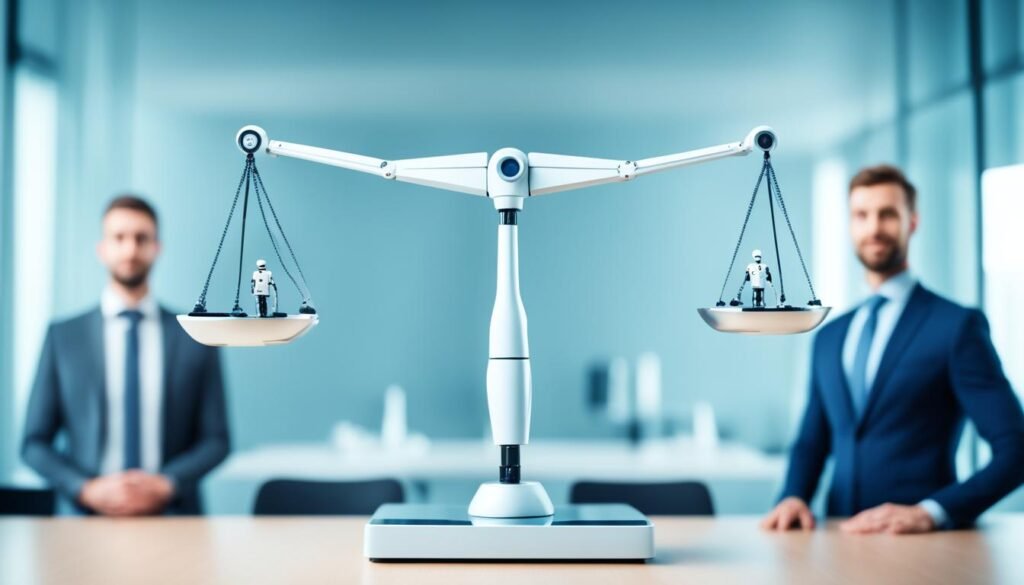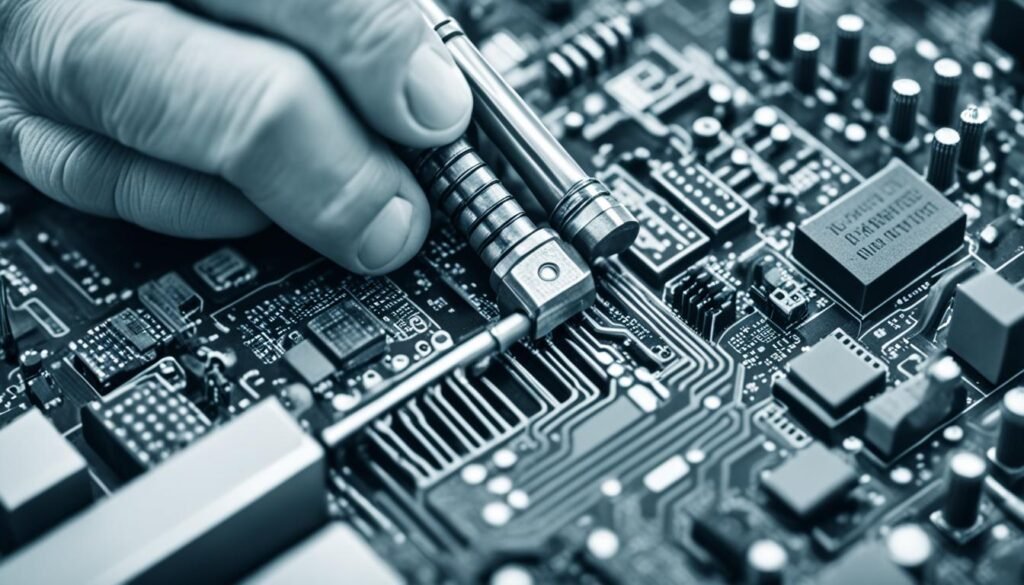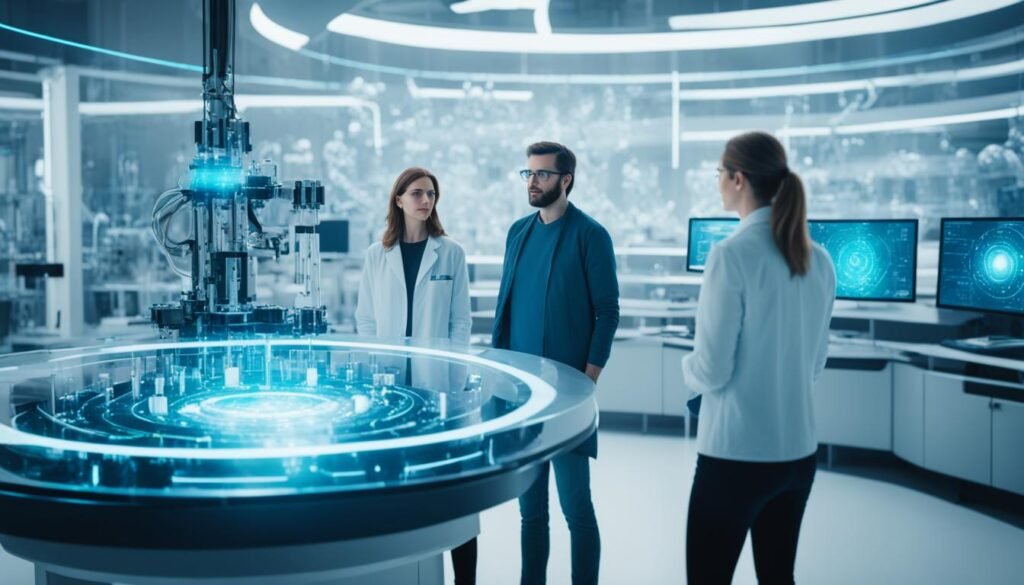In today’s world, Artificial Intelligence (AI) is seen as a solution to many complex issues. Recent advances in AI have led many to believe it can do everything humans do. But, it’s important to understand that AI isn’t a magic fix for all our problems.
AI has great potential, but it’s not a magic solution. It has its own limits and downsides. We need to see AI for what it truly is: a tool made by humans, not a magic wand.
Key Takeaways
- AI has limitations and cannot be considered a panacea for all problems.
- It’s important to understand the strengths and weaknesses of AI to manage expectations.
- AI should be viewed as a tool that can complement human capabilities, not replace them entirely.
- Responsible development and deployment of AI is crucial to ensure it is used ethically and for the benefit of society.
- Ongoing collaboration between humans and AI will be necessary to tackle complex challenges effectively.
The Allure and Potential of AI
Artificial intelligence (AI) is alluring because it promises speed and efficiency. It can analyze huge amounts of data much faster than humans. This makes it useful in many industries, like understanding customer behavior or driving cars on its own.
But, when we think AI can fix all our problems, we’re getting too optimistic. This view is dangerous.
AI’s Promise of Speed and Efficiency
AI algorithms are great at making quick, precise decisions. In healthcare, AI tools can look at medical scans fast and find problems early. This helps doctors treat patients better.
AI has also changed business by making things run smoother and faster. It helps companies work better and be more productive.
AI’s Ability to Analyze Vast Amounts of Data
AI is amazing at looking through huge amounts of data to find important information. This is super useful in marketing. AI can spot complex patterns in what customers do, helping companies make better products and ads.
But, AI isn’t perfect. It can help solve many problems, but it’s not a magic solution for everything. We need to use AI wisely, working with human creativity and ethics.
The Limitations of AI
Artificial intelligence (AI) has made big steps forward, but we must see its limits. AI learns from data and predicts based on patterns. Yet, it can’t create like humans do, with their spark of creativity and innovation. Humans can think differently and come up with new ideas that AI can’t.
AI also can’t truly feel human emotions. It can recognize and react to emotions, but it doesn’t have the empathy humans do. It might show emotions like jealousy, but it’s not the same as how humans feel.
| Limitation | Description |
|---|---|
| Lack of Creativity | AI systems are programmed to learn from data and make predictions, but they cannot replicate the human spark of creativity and innovation. |
| Inability to Truly Understand Emotions | While AI can recognize and respond to human emotions, it lacks the empathy and emotional intelligence that are central to human interaction. |
| Bias and Inaccuracy | AI systems can exhibit biases in decision-making processes, leading to discriminatory outcomes. They may also produce inaccurate or fabricated information, a phenomenon known as “hallucination”. |
| Limitations in Language and Context | English language nuances and context can pose challenges for AI content generators, leading to mistakes and misunderstandings. |
As AI becomes more common, we must understand its limits and risks. The points made here show why we need to work with AI and human intelligence together. This way, we can get the best results from both.
will ai solve all our problems
AI is making huge strides, leading many to think it can fix all our problems. But, the truth is more complex. AI has great potential, but it’s not a magic solution for every issue we face.
AI can only solve problems it’s programmed for. It uses the data given to it, and its abilities are limited by that data. Even with AI getting better, some problems might not be solved by machines alone.
AI won’t replace doctors and lawyers anytime soon. These jobs need a deep understanding of human feelings and complex decisions. AI might help with simple tasks, but it won’t fully replace skilled workers in those areas.
As AI gets more advanced, new challenges and risks will come up. We need to deal with issues like bias, privacy, and ethical concerns in AI. These problems must be handled carefully to make sure AI helps everyone.
In conclusion, AI will be key in solving many problems, but we must see its limits. It’s a powerful tool that can boost human abilities, not replace them. By understanding AI’s true strengths and weaknesses, we can use it in a way that helps us, not hinders us.
“AI is a tool, not a magic wand. It can help us solve many problems, but it cannot replace human creativity, empathy, and judgment.”
As we move forward with AI, keeping a balanced view is key. AI will keep getting better and tackling tough problems. But, it’s important to remember it can’t solve all our issues. By seeing AI as a tool and valuing human intelligence, we can make the most of this technology for a better future.
AI’s Inability to Make Ethical Decisions
AI is becoming a big part of our lives, but can it really handle ethical decisions? Sadly, the answer is no. AI works with set rules and doesn’t understand right and wrong like humans do.
Dealing with ethical issues needs a deep look at values and the situation. AI can’t feel empathy or make choices based on complex values. AI’s lack of ethical decision-making is a big issue as it gets more involved in making choices in different areas.
Companies are using AI more for things like hiring, planning work, and helping customers. But giving AI big moral decisions is a worry. Even with rules for “ethical AI,” they mainly focus on the results, not how decisions are made.
“The proliferation of documents outlining principles for AI ethics and the growing convergence around key principles may prove insufficient if the goal is to delegate ethical decision-making to AI systems.”
AI doesn’t really get ethics, so we can’t trust it with big moral choices. Rules for ethical AI might not work well. They could be ignored, making companies not accountable for bad AI, and making it seem like AI is more responsible than it is.
As AI’s role grows, we must see its limits in making ethical choices. We need to focus on human control, being open, and understanding the ethical sides of AI. By knowing AI’s limits, we can make sure AI moves forward with our values and ethics.

The Need for Human Oversight
As AI gets better, we must remember it can’t work alone. These systems are fast and efficient but can make mistakes. This is a big problem in important areas like healthcare or driving cars by themselves.
The U.S. military wants “meaningful human control” over AI systems, as seen in DoD directive 3,000.09. The U.N. also stresses the need for human control over deadly AI weapons. This shows how important it is to have humans check on AI.
The European Commission wants AI systems like facial recognition to have human checks. This is to stop or lessen risks. The GDPR also protects people from decisions made only by machines.
Many places are focusing on making sure humans can control AI systems. This idea has sparked talks on what good oversight looks like. Scholars discuss automation bias and if humans can really watch over complex AI.
Still, it’s clear we need human oversight. AI should help us, not replace us. By making sure humans can step in and make decisions, we can use AI safely. This way, AI helps us without taking away human judgment and responsibility.
| Occupations at Risk of AI Replacement | Historical Examples of Job Evolution | Suggestions for Incorporating AI |
|---|---|---|
|
|
|
Adding AI to work needs a careful plan. We should aim for a mix where humans and AI work together. As AI gets more advanced, like AGI and ASI, it might take a while to move away from human jobs. It’s key to have ways for humans to check on AI decisions.
“The world’s first global AI safety summit brought together 28 countries to address universal collaboration on AI regulation.”
Working together, businesses and industries can use AI’s power while keeping human skills and creativity. This mix of AI and human oversight is key to tackling challenges and making the most of this new tech.
The Myth of the Omnipotent AI
Artificial intelligence (AI) has become a powerful tool, speeding up many processes and opening new doors in various fields. Yet, a common myth says AI can solve all our problems by itself. This idea comes from science fiction and overly positive views, hiding AI’s true nature – a complex tool, not a magic solution.
AI isn’t a magic wand for our problems. It’s a technology that, when used wisely, can greatly improve how we solve problems. For example, machine learning models are great at predicting stock trends in finance and diagnosing illnesses from images in healthcare. But AI still needs rules and learns from data, lacking the full understanding needed to tackle our complex issues.
The worry that AI might become a superintelligent being, like a god, adds to the debate on how to manage AI. AI’s big impact on many areas is clear, but it’s still a tool that needs humans to guide it, check it, and make sure it’s used right.
As we move forward with AI, it’s important to set realistic goals and see AI for what it is. Seeing AI as a partner, not a hero, lets us use its strengths while keeping human creativity, innovation, and ethics valuable.
AI as a Tool, Not a Magic Wand
AI is a strong tool, but it’s not a fix-all for every issue. It needs human help, direction, and ethical thought to be used well. The idea that AI can do everything on its own hides its true nature – a tool that helps us solve problems, but can’t replace human touch.

“AI systems still require human guidance for setting objectives, defining parameters, and interpreting results correctly.”
As we delve deeper into AI, keeping a balanced view is key. By seeing AI as a partner, we can fully benefit from it while keeping human judgment, creativity, and ethics important.
The Phenomenon of Computational Irreducibility
As AI gets better, we wonder if it can solve all our problems. But, the idea of computational irreducibility shows a big challenge for even the top AI systems. It says we can’t fully predict or solve complex systems, even if we know the rules.
The Principle of Computational Equivalence
Stephen Wolfram’s Principle of Computational Equivalence says all computations are equally complex. This means top AI systems can’t skip the basic work needed to understand complex systems. There’s a minimum effort needed to know how a complex system works.
Pockets of Computational Reducibility
Computational irreducibility sets a limit on predicting and controlling complex systems. But, it also shows there are areas where we can find easier solutions. By using these areas, AI systems can help solve specific problems, working with human creativity and decision-making.
This idea of computational irreducibility changes how we see AI. It shows AI isn’t a magic solution to all problems. Instead, AI and human intelligence should work together. AI helps us solve problems, but we keep the important roles of human judgment, creativity, and ethics.
“The development of technology and automation has been the main change in human history. But this process has limits, as the concept of computational irreducibility suggests. Even the most advanced AI systems cannot bypass the fundamental computational work required to understand the behavior of complex systems.”
AI’s Role in Scientific Discovery
AI is changing the way we explore science, making big strides in solving complex problems. It helps predict weather patterns with great accuracy and finds new protein structures. AI can handle huge amounts of data and find patterns we miss, speeding up scientific progress.
AI as a Linguistic Interface
AI is changing science by acting as a bridge between humans and computers. Large language models (LLMs) let researchers easily use the vast knowledge at their fingertips. These models act like a smart “autocomplete” feature, offering answers and next steps in research.
AI for High-Level “Autocomplete”
AI is also boosting scientific discovery in many ways. Models like FourCastNet predict weather much faster and more accurately than before, helping us make better decisions. DeepMind’s AlphaFold has changed how we understand protein structures, winning big in competitions.
But, using AI in science comes with its own problems. The issue of not being able to reproduce some scientific results is still there. Yet, AI can make experiments cheaper and easier to run, helping us figure out if results can be repeated.
The future of AI in science looks bright. It’s set to tackle big issues like fighting diseases and ensuring food security in Africa. AI will also help us understand space and climate better. By using AI, we can make new discoveries and keep pushing the limits of what we know.

The Collaborative Approach
The future of AI is all about working together. It’s about using AI’s power to handle big data and find patterns. At the same time, we count on human skills for creativity, making judgments, and making ethical choices. We know that AI is a big help in solving problems, but it’s not the only answer.
Studies show that when humans and AI work together, we see the biggest gains. Firms that just try to cut costs by using AI won’t see lasting success. AI can actually make businesses more flexible, fast, and able to make better decisions. It also helps in making products and services more tailored to what customers want.
Leveraging AI’s Strengths
AI is getting better at things like diagnosing diseases, translating languages, and helping with customer service. But it’s really about helping humans do their jobs better, not taking over. AI tools are getting smarter at working with us, making our interactions with technology stronger.
Preserving Human Judgment and Creativity
A team at MIT’s CSAIL worked on a way to use AI systems to talk and argue with each other. This helps them come up with the best answer to a question. It’s like how humans talk things out in groups, aiming to make better decisions and keep language models accurate.
This method shows how language models can work better together. But, it’s still missing the deep discussions we have with each other. AI could be great at sharing knowledge and helping with research ideas. But, it’s not yet fully using its power to encourage teamwork in research.
“The future of AI lies not in isolation, but in collaboration – a symbiosis between human and machine.”
The Future of AI in Problem-Solving
The future is changing fast, and the mix of human and ai future is key to solving big problems. AI’s role in solving problems is strong, but it’s even better when combined with human creativity and empathy. This mix can tackle challenges quickly and efficiently.
Groups and governments are using ai future in many ways. For example, Beijing is using facial recognition for ID cards, and health groups use AI to spot diseases. Corporate leaders and policymakers see AI’s value. It works faster, costs less, and lets people focus on creative tasks.
But, AI has its limits. As we use ai and human collaboration more, we must watch out for risks. These risks include powerful robots or new ways for some to control others, as warned by Stephen Hawking.
The future of AI is about finding the right balance between AI and human skills. AI can analyze big data, automate tasks, and make things more personal. But, we must keep human judgment, creativity, and empathy at the core. This way, we can fully use AI’s power.
- AI helps in medical diagnosis, treatment planning, finding new drugs, and robot-assisted surgery.
- In manufacturing, AI helps with automation, predicting when things need fixing, checking quality, and precise inspections.
- For shopping and online sales, AI makes shopping personal, predicts demand, and helps manage stock.
- In finance, AI spots fraud, manages risks, and helps in trading for better profits.
- Transportation gets better with AI through self-driving cars, finding the best routes, and predicting maintenance needs.
Looking ahead, the possibilities are vast. AI’s role in solving problems can tackle big global issues like climate change and preventing diseases. By understanding AI’s strengths and limits, we can open new doors to innovation and solving problems. And, we keep the human touch at the center.
“The true potential lies in the seamless integration of human creativity, empathy, and judgment with the speed, efficiency, and data-processing capabilities of artificial intelligence.”

Conclusion
AI is a wonder of human creativity, full of potential and power. Yet, it’s not a fix-all solution for every problem. It brings many advantages like making things faster, reducing mistakes, and understanding data better. But, it can’t match human creativity, innovation, or emotional smarts.
Working together, humans and AI can solve complex problems. By using AI’s speed and analysis, and humans’ judgment, creativity, and empathy, we can overcome big challenges. AI should help and empower us, not replace our thinking and decisions.
Will AI solve all our problems is a myth. AI isn’t the answer to everything. But, with careful development and the right approach, it can be a strong ally in making life better. The AI benefits are clear, but we must also face the AI limitations. Let’s aim for a future where AI and human collaboration lead to progress and positive change for everyone.
FAQ
Can AI solve all our problems?
No, AI can’t fix everything on its own. It has a lot of potential but can’t replace human creativity, empathy, or ethical thinking.
What are the limitations of AI?
AI can’t replace human creativity or emotions. It can’t make moral decisions or work without human supervision. It’s a powerful tool, but not all-knowing.
How does the concept of computational irreducibility impact AI’s problem-solving abilities?
The Principle of Computational Equivalence shows there are limits to predicting complex systems. Computational irreducibility means figuring out complex systems takes time and effort. This limits AI’s ability to solve everything.
What is the role of AI in scientific discovery?
AI offers a new way to use computational power, helping with scientific tasks. But it can’t replace human creativity or judgment in advancing science.
How should we approach the future of AI in problem-solving?
The future of AI is about working together with humans. We should use AI’s strengths and human skills for creativity, judgment, and making ethical choices. AI is a great tool, but humans are still essential.
